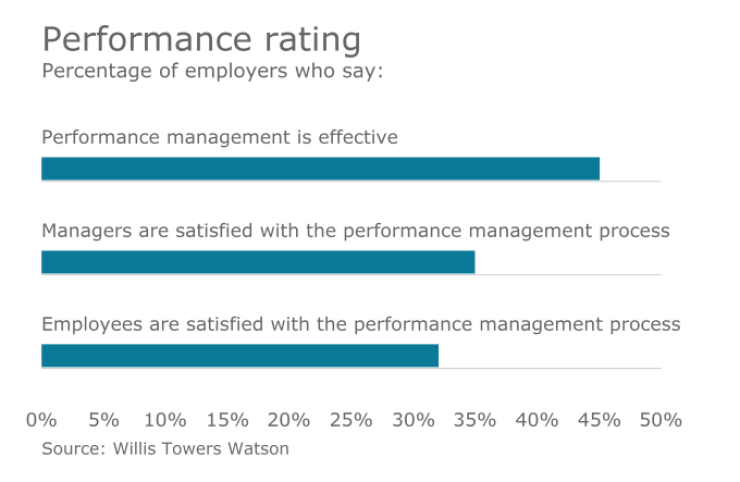A new study from Aon Hewitt says that many companies that profess to getting rid of performance ratings simply move the rating system underground. This often leads to a lack of transparency and undermining trust between managers and employees.
The consulting company’s survey of financial services organizations reveals that nearly all still use a traditional performance rating scale. Parallel research in the technology sector shows that the percentage of companies that do not use performance ratings is also just 10%. And of those that currently use ratings, only 8% are considering whether or not to drop the practice.
“This is hardly a seismic change. It’s more of a minor tremor,” says Levi Segal, a partner at Aon Hewitt.

“Some companies that say they ‘blew up’ their performance management system have made necessary and laudable modifications like moving from a number rating to a descriptor,” he says, adding, “but they are marketing this as revolutionary change.”
See also:
Segal believes that the main reason that performance management is such a fraught exercise hated by HR, managers and employees alike is that it is essentially about managing people, and managing people is never easy. “People just don’t like assessing other people’s performance. No one likes to judge or be judged,” he says.
He also identifies the almost across-the-board practice of promoting technical experts who are not inclined to be the best managers or leaders into management positions as a key problem.
Compounding the question of whether or not to get rid of ratings is the employees’ view of the practice. Eighty-eight percent of “top-performing” employees in Aon Hewitt’s 2016 Workforce Mindset Study as compared to 67% of millennials and 64% of all employees agreed that companies should review performance and this should involve a rating.
“High-performers are attracted to organizations that recognize their contribution and if you don’t, they will go somewhere else,” Segal says. “The flip side is also true. Weak performers will self-select out of organizations where there is a strong recognition of high performance.”
Morton Salt has 3,000 employees in more than 20 production facilities in the U.S., Canada and the Bahamas. About one-third of its employees are salaried (as opposed to hourly), including engineers, production supervisors, finance, sales and marketing people.
When Matt Beliveau took over as the chief human resources officer at Morton Salt two years ago, he discovered that 75% of the salaried workforce did not have a formal performance management system with a consistent approach, set of steps and tools. There was also no connection between performance and any sort of variable pay.
Based on both anecdotal employee feedback and the results of engagement surveys, he learned employees were actually looking for more feedback to understand how they were performing relative to their peers. They also expressed a desire for more development opportunities and access to variable or incentive pay based on performance.
The company decided to implement a performance management system using qualitative ratings instead of numerical rankings. “We rate employee performance as exceptional, high, solid or valued,” Beliveau says. “Then at the lower end of the spectrum we talk about the need for performance improvement or unsatisfactory performance.”
But he points out that unlike many other companies there isn’t a forced distribution or stacking that requires specific percentages of employees to be assigned to each level. “However, we certainly have some guidelines about how to assign ratings because as I once heard in college, ‘it takes the bottom half of the class to make the top half positive,’” Beliveau says. He also notes that a key objective of assessing employee performance is the ability of managers to coach and give feedback.
Beliveau’s reaction to companies that say they are getting rid of ratings is cautious. “I think that companies with a long track record of exceptional leadership development and a focus on coaching employees to perform well may be able to assess and differentiate performance without formal ratings,” he says. “The question I do have is how they can still somehow designate their highest potential employees and manage that group.”
“If you are focused on managing your talent, you are going to find a way to put them into categories so you may as well be transparent about it."
He also agrees that having what amounts to an “under the cover” rating system is not necessarily a good idea. “If you are focused on managing your talent, you are going to find a way to put them into categories so you may as well be transparent about it,” Beliveau says.
Segal agrees. “The most common false choice we encounter is that we can either get rid of ratings or be stuck with bad performance management,” he says. “Instead, organizations should pause and ask whether these are their only choices. What about actually fixing performance management to ensure it drives your business and strategy?”





